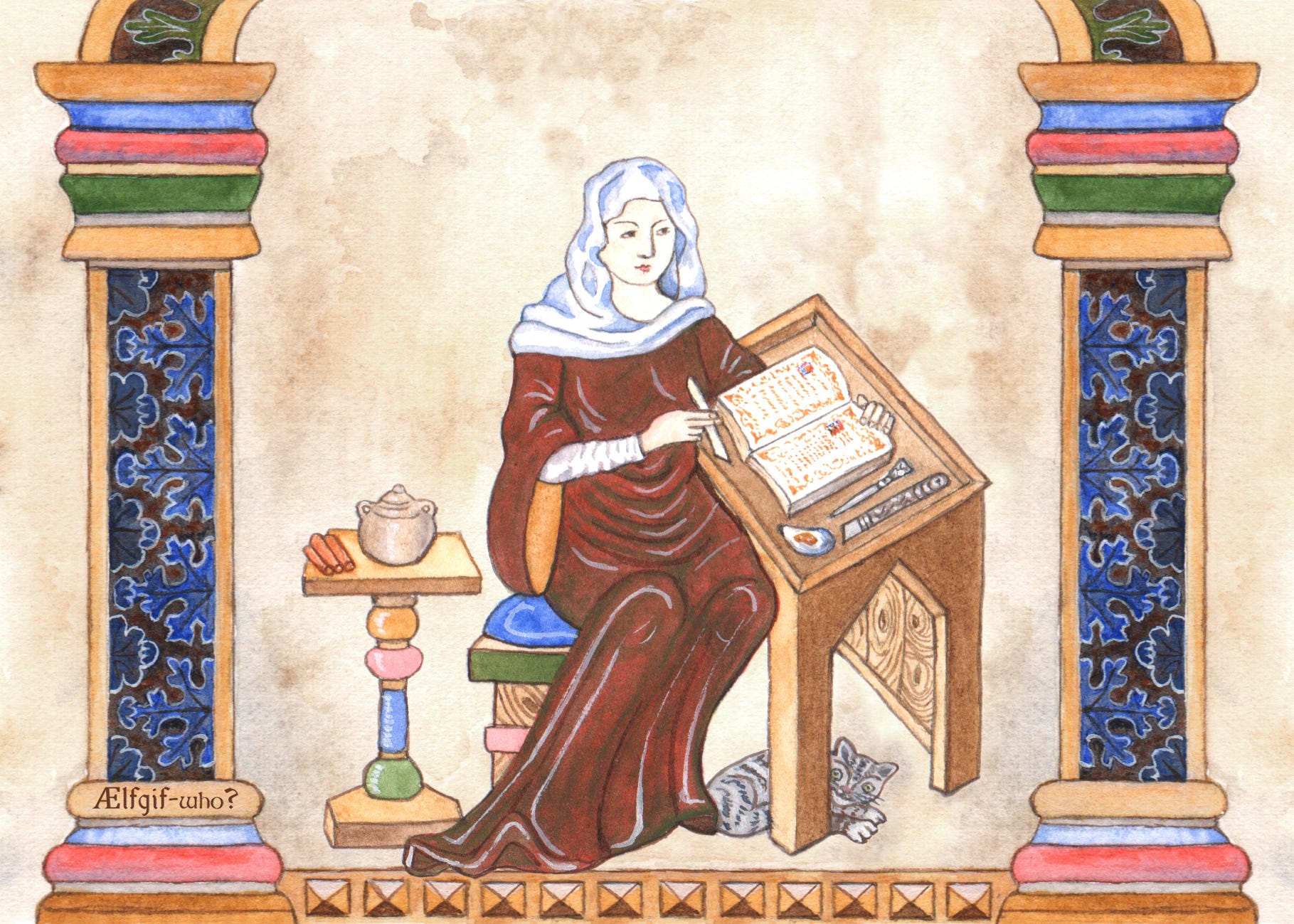
Ælfgif-who? provides short biographies of early medieval English women. Click on the podcast player if you’d like to hear this newsletter read aloud in my appealing Yorkshire accent.
Eadburg: A manuscript mystery come to light
A conversation with University of Leicester PhD student Jessica Hodgkinson, who made this fascinating discovery
If you’re keeping your ear to the ground for big news about medieval women, you might have already heard about the recent discovery of several inscriptions of the woman’s name Eadburg in an early medieval manuscript. While working in the Weston Library’s rare books and manuscripts reading room one day in 2022, University of Leicester PhD student Jessica Hodgkinson discovered an inscription in an eighth-century manuscript, that was barely visible with the naked eye. The inscription was of the woman’s name ‘Eadburg’. After further investigation by the ARCHiOx project using state-of-the-art 3D technology, many other previously unseen instances of this name were found etched into the manuscript, as well as various other marks and drawings.
Jessica was kind enough to chat to me about the significance of these discoveries, and the important question of who Eadburg might have been - including two possible candidates whose biographies have already featured on Ælfgif-who?! These discoveries have huge implications for the study of early medieval women’s book culture, which is the topic of Jessica Hodgkinson’s PhD research, funded by the AHRC Midlands4Cities consortium. Paying subscribers of Ælfgif-who? will shortly receive an extra newsletter about this fascinating research into how women owned, created and interacted with books. So if you are a free subscriber and are desperate to know more about this fascinating subject, do consider upgrading your subscription:
The manuscript that contains the Eadburg inscriptions is called Bodleian Library, MS Selden Supra 30, and is a copy of the Acts of the Apostles - a book of the New Testament of the Bible. The manuscript probably originated in Kent sometime between 700 and 750, judging by the style of the script. The text was initially copied by two scribes, but their identities are unknown. These two scribes were evidently working on the manuscript at the same time, as a page was left unused at the end of the first scribe’s stint. On this page, a third person has written two prayers, and in one of these prayers has referred to herself in the Latin feminine. This clearly demonstrates female involvement in the creation and use of the book.
It was because of this evidence that Jessica Hodgkinson, whose PhD research is on early medieval women’s book culture, went into the Bodleian Library in Oxford to take a look at the manuscript in person. She told me that:
‘The prayer written from a woman’s perspective shows that this book was being used by at least one woman if not a group of women. Even discounting any inscriptions, what we have here is a book with clear evidence of female use.’
One inscription on page 47 of this manuscript had already been noted in the 1930s - which appears to be EADB+E+. It was suggested that this could be an abbreviation of the Old English woman’s name Eadburg, but this theory had not yet been confirmed. However, this changed last year after Jessica took a careful look at the manuscript. She told me:
‘I prefer to physically interact with manuscripts because that is how the women who I study would have interacted with them. This is really important when thinking about the contexts in which these books were actually used. I spend as long as I can with all the manuscripts I study. Any detail could be important, from hair follicles in the parchment to ruling patterns. When I saw Selden Supra 30 I turned all the pages and looked at it from every possible angle.’
This attention to detail paid off, as Jessica soon noticed something that looked like an inscribed letter in the lower margin of page 18. Upon looking at this with a magnifying glass, she could see the name ‘Eadburg’. And fortunately, the technology was available to investigate this discovery further. Jessica said:
‘At the time I made this initial discovery, the ARCHiOx project was happening at Oxford, a collaboration between the Bodleian Libraries and the Factum Foundation, funded by the Helen Hamlyn Trust. They have developed scanners that use angles of light to illuminate details that you can’t see through normal photography. Not only could we see ‘Eadburg’, but we saw that it was part of a much longer inscription that was not visible to the naked eye.’
In looking at this manuscript the ARCHiOx scanners revealed multiple other inscriptions of Eadburg’s name on many different pages. Not only this, but there were also drypoint doodles of people and scenes. Without the serendipitous combination of Jessica’s careful eye and this recording technology these inscriptions may have never been discovered.
The precise meaning of these engravings is still under consideration, but Jessica believes them, and their placement within a Biblical text, to be significant. She told me that:
‘The inscriptions seem to be very intentional interactions with the manuscript and the text within it. While at first glance these might look like doodles, the addition of the names and drawings next to particular parts of the text are deliberate.’
Perhaps the most interesting questions, especially for readers of Ælfgif-Who?, is who this Eadburg might be, and who was writing her name over and over in a manuscript. Jessica told me that:
‘It’s difficult to know who wrote the inscriptions but it’s entirely possible that it was Eadburg herself interacting with the text. Some people have speculated that the inscriptions must have been made by a man, and even that he must have been in love with her, but this seems to be based, at least in part, on the false assumption that women could not have been interacting with books in this period.’
There are currently three known Eadburgs that have been under consideration as the one mentioned repeatedly in Selden Supra 30. One is Abbess Eadburg of Minster in Thanet, a feasible figure given the manuscript’s probable Kentish origins. Two other candidates will be familiar to readers of Ælfgif-who?. One is Eadburga from newsletter number 18, the scribe and poet who wrote with a sliver stylus - perhaps even the kind of stylus that would have been used to make these inscriptions. The other is the notorious Queen Eadburh from newsletter number 22, who is said to have poisoned her husband and fled to the continent where she lived a debauched life.
Perhaps after these inscriptions have been studied more, I will have to return to one of these women and update her biography to include her involvement with Selden Supra 30 - but Jessica stresses it’s important to keep an open mind:
‘It is possible that Eadburg was one of these known figures. However, many women participated in literate culture, and it is equally possible that the Eadburg in MS Selden Supra 30 was an entirely different woman, about whom nothing is yet known. We may have a better inkling about who she is after further research into these inscriptions.’
Whether the Eadburg in these inscriptions is a new figure or a known one, and whether it was her who wrote her name in the manuscript or someone else, these discoveries obviously have huge significance for understanding early medieval women and how they used and interacted with books. Paying subscribers will hear more on this subject in your inboxes soon.
Further Reading:
Bodleian Blog: Women in the Margins: Eadburg and Bodleian Library, MS. Selden Supra 30 by Jessica Hodgkinson and John BarrettSmithsonian: Woman’s Name and Doodles Found Hidden in 1,200-Year-Old Religious Manuscript
The Guardian: Woman’s name and tiny sketches found in 1,300 year old medieval text
University of Leicester: Hidden inscriptions hint at mystery medieval woman’s identity
More on the ARCHiOx Project
This is a public episode. If you’d like to discuss this with other subscribers or get access to bonus episodes, visit florencehrs.substack.com/subscribe
More Episodes
 2023-06-26
2023-06-26
 2022-09-30
2022-09-30
 2022-08-19
2022-08-19
Create your
podcast in
minutes
- Full-featured podcast site
- Unlimited storage and bandwidth
- Comprehensive podcast stats
- Distribute to Apple Podcasts, Spotify, and more
- Make money with your podcast
It is Free
- Privacy Policy
- Cookie Policy
- Terms of Use
- Consent Preferences
- Copyright © 2015-2024 Podbean.com






